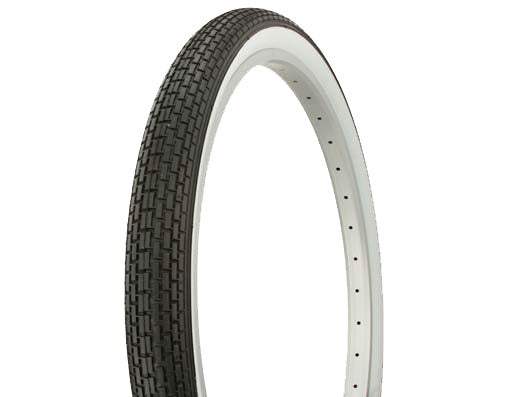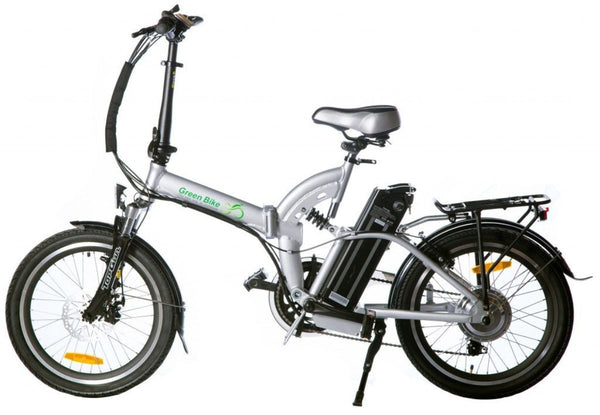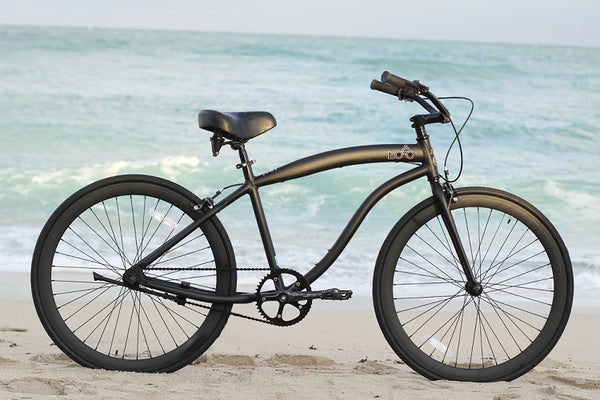If you are looking to replace a beach cruiser tire due to damage or wear or to just upgrade the look and feel of your bike, this is a guide to finding the right beach tire.
We’ll review how to determine the tire size and tire width to start and then go over things like tread type, colors, PSI and more.
Let’s start with making sure you get the right size and width. This guide will help with almost any brand of beach cruiser - Sixthreezero, Firmstrong, Micargi, Huffy, Kent, Schwinn and more.
Tire Size (aka Diameter)
The first thing to do is determine the correct tire size. The common way to refer to size is the diameter of the outside of the tire. You can also refer to the inside diameter (known as ISO) and we’ll touch on that below.
Fortunately, tire sizes are pretty standard and many cruisers are described by the size, such as a 26” beach cruiser or 24” lowrider cruiser. Here is a quick rundown of the common sizes for cruisers:
- Adult beach cruisers are almost always 26 inch (26”).
- Some womens’ and teens’ cruisers are 24 inch (24”).
- Kid’s cruisers are usually 20 inch (20”).
- Chopper or Lowrider cruisers can have 20 inch or 24 inch tires. Some bikes may even have two different-sized tires depending on the setup so be sure to check.
- Finally, some hybrid-type cruisers will have the larger diameter 29 inch or 700C tires.
However, it is good to make sure that you are getting the correct size so here are some additional ways to check:
See what the manufacturer or brand listed as the tire size. Generally, the tire size will be listed on the bike specifications. You will find a description of something like - 26” x 2.125” tires - or something similar. This can be found in the user’s manual, the manufacturer’s website or on the description of the retailer’s website. The first number (i.e. 26”) is the tire size while the second number is the tire width, which we will discuss below.
Check the current tires. You can also look at the current tires on your beach cruiser to determine the size. Look at the sidewall of the tire for numbers that look like “26 x 2.125” or similar. This is called the ‘common size’ for the tire. There is also a second set of numbers called the ‘ISO size’, which are another way of determining the tire size. We’ll discuss ISO size below. See the image below to determine both the common sizing and ISO sizing.

What is the difference between common tire size and width and ISO tire size and width? Common tire size and width is a more consumer-friendly way for how most of the industry refers to the tire sizing. ISO is a more technical and precise way of measuring tires that comes from Europe. ISO tire size is the inside diameter of the tire in millimeters (whcih also matches the diameter of the wheel) while ISO Tire Width is the nominal width of the tires in millimeters.
The ISO size is really only important if you are dealing with vintage tires or you are measuring the wheels as shown below. See below on both wheel measuring and vintage tires to learn more.
Measure the wheels. If none of the above methods work, you can also measure the diameter of the wheels from the outside of the rim to the outside of the rim. (Remember the wheel is the metal rim and spokes that the tire mounts to and not the tire itself). Below are the diameters of wheels and the equivalent tire sizes for the most common sizes. As you can see, this is where the ISO number comes in handy as it matches the tire exactly to the wheel.
|
Tire Size |
Wheel size/dia. in mm (aka ISO) |
Wheel size/diameter in inches |
|
20” |
406 mm |
16 in. |
|
24” |
507 mm |
20 in. |
|
26” |
559 mm |
22 in. |
|
26” (vintage) |
590 mm |
23.25” |
|
29” / 700C |
622 mm |
24.5” |
VINTAGE BIKE NOTE: Some older cruisers may have a different 26” tire than what modern cruisers have. They are actually a larger 26” tire (by 1.25” on the inside diameter of the tire) and so standard cruiser tires won’t fit. To determine if you have a vintage 26” or a standard 26”, you need to either look at the width of your current tire listed on your tire, the ISO number on the sidewall of your current tires (see note above) or measure the wheels. The width for vintage wheels will always be a fraction like 1-⅜” vs a decimal like 1.75” of standard tires. For the ISO number, you’ll look for the number in parentheses on the sidewall. Vintage tires will have a 590 while standard tires will have a 559.
Tire Width
Once you determine the size, you can determine the tire width. For reference, the tire width is roughly the outside width of the tire itself when mounted on the wheel and inflated. We say roughly as manufacturers will vary in how close the width is to the actual listed measurement. However, it is usually close enough for most people.
Most beach cruisers are between 1.75 and 2.125” in width, including 1.95”, 2” and 2.1” widths. 2.125” is the most common width and the default for most adult cruisers.
However, unlike the size, which has to exactly fit your wheel, it is possible to change the width of tires if it can on your frame and wheels.
To determine your tire width, here is what we recommend:
Check to see what the manufacturer listed as the tire size. Like above for tire size, you can also check the user’s manual, manufacturer’s website or the retailer’s website for the original description of the bike to see what was listed. It is the second number of the size and width on the sidewall.
Check the current tires. Like above, you can check the sidewall of the tire. The common tire width will be the second number on the sidewall of the tire (i.e. 26 x 2.125).
You can now find a tire width that fits one of those descriptions. Getting the same tire width is the safest bet.
However, sometimes people want to change the width or can’t find the width they want.
Some people may want to go narrower as those tires weigh less and tend to roll faster. They can also provide a more sporty look.
If you want to go narrower, you’d need to make sure your wheel can support that. The best way to do that is measure the inside of the rim of the tire and then see if your tire can accommodate that width. The tire should be between 1.5 and 2.3 times wider than the rim width. For example, if your internal rim width is 25 mm (1 in.) , then you could go between 1.75 and 2.25” width tires. If it wider, than you may not be able to get a 1.75” tire and you should go with 1.95” or wider.
You may also go wider if you want a more comfortable ride, more grip on the road or just a different look. This is now more popular with the fat tire bike craze. However, you need to make sure that wider tires can work on your beach cruiser. In general, it is difficult to install wider tires on cruisers. You are usually limited on the width of the frame - especially at the chain or seat stays - as well as the rim width.
If you want to try, you’ll just need to measure the inside width of the frame on your current tire to see if there is enough room for a wide tire. Be sure to leave some space (½” or so either side to be safe) given the variations in . Also, be sure to take into account any clearance for fenders if installed. Also check the tire to rim width compatibility as mentioned above.
Now that you’ve determined the size and width, you can start looking at other options:
Beach Cruiser Tread Type
The next thing to consider is the tire tread you want. Most beach cruisers have a low tread knob for riding on pavement and concrete that also provides some traction for sand and mud. Patterns may be brick tread, diamond tread, semi-slick and slick. Frankly, most of them work for cruisers so it may come down to the look you want. Here is quick overview of most of them:
- Brick pattern. Provides a classic vintage look with reasonable speed and traction.
- Diamond pattern. Also known as a Goodyear tread, it provides a more modern while providing a little more traction in sandier or wet conditions.
- Knobby tires. Provides maximum traction but limited speed and more of a hybrid/mountain bike look.
- Semi-slick. Rolls faster with limited traction. This can be small grooves or micro treads.
- Slick tires. Rolls fasters with limited traction. Provides the cleanest look.
Beach Cruiser Tire Color
There are lots of colors to choose from with beach cruiser tires, including combinations of different tread and sidewall colors. It is really up to you.
There are different philosophies on color matching with the rest of your bike. You can match the tires to the saddle and bar tape or grips for a more matched look. Or you can get contrasting tires for a more fun or interesting look. Either way, beach cruiser tires aren’t too expensive so it is easy to try different things to get the look you want.
Other Considerations
There are a few other things to consider:
PSI: Most beach cruiser tires range from 35 to 65 PSI. The higher PSI, the firmer the tire when riding. 40 PSI is considered an ideal pressure for comfort and performance. However, that doesn’t mean you need to find a 40 PSI tire. You can also use a 65 PSI tire and still run it at 40 PSI without an issue. If you decided you want a firmer tire, you can always increase the PSI to the tire later.
Reflective: Some cruisers have a reflective strip on the sidewall so you will be better seen at night. This is important for nighttime riding as cruisers don’t always have the safety reflectors or lighting that other bikes have.
Bead Type: Almost all cruiser tires have wire beads so there isn’t much to think about. Folding beads are only found on road or mountain bike tires and aren’t necessary for cruiser tires.
Weight: For beach cruisers, tire weight isn’t too important. The weight difference in comparison to the overall weight of the bike will be minimal.
That’s an overview. Be sure to check out our wide selection of tires at Bikes Xpress



